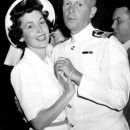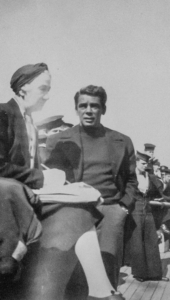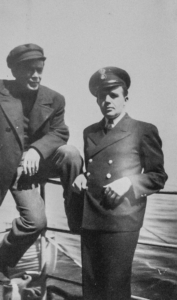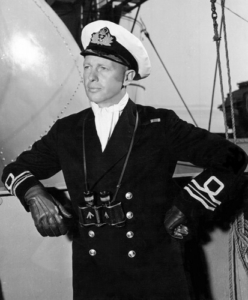Commander Hollywood
His films were full of action and adventure, but for Hollywood director John Villiers Farrow, his own life may have been the biggest adventure of all.
Farrow, an Australian, was a sailor by training and profession; he attended the Royal Naval Academy in England. He was also a successful film maker, screenwriter and novelist who travelled the world as a marine researcher. These travels included a long stint in Tahiti, where he wrote a French-English to Tahitian dictionary that became a standard reference work for many years.
In common with many larger than life characters, it is difficult to separate myth from man when considering Farrow’s exploits.
An intriguing aspect of his career as a sailor surrounds his status as an Honorary Commander in the Canadian Navy, a rare distinction
John Farrow was already a successful film director when the Second World War began. Determined to serve, he joined the Royal Canadian Navy (RCN), stating that he was “a fairly competent seaman“. He had first expressed interest in joining the RCN as early as 1936, and later that year had his name placed on the Emergency List for “service in time of war”
In the course of his career, he was connected with HMCS DISCOVERY in Vancouver, Canada’s longest serving Naval Reserve Division, and the armed yacht HMCS ELK. As his obituary in The Crowsnest magazine notes, Farrow was at one time the Controller of Naval Information, an appointment he took up in June 1940.
Farrow was appointed as an acting lieutenant in the Royal Canadian Naval Volunteer Reserve (RCNVR) in March 1940. Retired RCNVR Submarine Commander Fred Sherwood recalls being in Ottawa in charge of recruitment when Farrow enlisted: –
“Anybody who wanted to join the Navy was to come and see me … I ‘joined’ a lot of people; one was John Farrow, who married Maureen O’Sullivan. Mia Farrow was their daughter.”

On leave after months of active sea duty, John Farrow dances with wife Maureen O´Sullivan at the Stork Club. July, 1943.
In April 1941 he was loaned to the Royal Navy and appointed to HMS Goshawk naval base in Trinidad, and served as assistant to the Senior British Naval Officer, Curacao. He returned to Naval Headquarters, Ottawa, in late 1941, having contracted typhoid fever, and was given a medical discharge in January 1942. While convalescing, he directed the film Wake Island.
In July 1943, his services were once again requested by the Navy in connection with the proposed Royal Canadian Navy Show; he served as a technical consultant. He was commissioned as Honorary Commander at this time. It’s been suggested that he received the distinction because he and his famous wife, actress Maureen O’Sullivan, were Hollywood royalty and the powers-that-be at Naval Service Headquarters enjoyed rubbing shoulders with them. Farrow’s Hollywood connections also provided access to a powerful public relations machine.

Actors Lillian Gish (left) and Paul Muni pictured during the filming of Joh Farrow’s production Commandoes Strike at Dawn. Photo Catalogue No. VR2002.182.108
Before the cessation of hostilities in 1945, Cdr. Farrow was again summoned to Ottawa, travelling to Britain for work in connection with the Director of Special Services. He was awarded the Canadian Forces Decoration in September 1953.
He maintained his connection with Canada’s Navy after returning to Hollywood, entertaining men from Royal Canadian Navy ships when they visited Los Angeles.
Farrow’s directorial career prospered – he received an Academy Award nomination for his direction of Wake Island. He contributed to the war effort with Commandoes Strike at Dawn, which was shot with extensive cooperation from the Canadian Navy (for more information on Commandoes and Canadian naval vessels on film, see our website article Hollywood and Canada’s Navy.) Another wartime morale raiser was The Hitler Gang, Farrow’s documentary drama on the Nazis’ rise to power.
John Farrow was also a successful author. Damien the Leper, his biography of Father Damien de Veuster, a Catholic priest who worked extensively with lepers in the Hawaiian islands, was reprinted many times, and he also produced a history of the Papacy, Pageant of the Popes, in addition to writing numerous screenplays.

Actor Paul Muni pictured with an unidentified officer aboard HMCS PRINCE DAVID during the filming of the wartime production Commandoes Strike at Dawn. Photo Catalogue No. VR2002.182.103
Postwar, he directed some of his finest films, including a stylish thriller The Big Clock, the well regarded Two Years Before the Mast, and the Western Hondo, starring John Wayne.
In 1953, although he was by now an American citizen, he was appointed an honorary Commander of the British Empire (CBE), a British honour (the Most Excellent Order of the British Empire) originally instituted by King George V to honour the many thousands of people who served in numerous non-combatant capacities during the First World War. It is not known what Farrow did to earn his CBE.
During the 1950s, Farrow resisted Senator Joe McCarthy’s attempts to conduct a witch hunt for suspected Communist sympathisers amongst members of the Screen Directors’ International Guild. He went on to work for several different studios. As co-writer of Around the World in Eighty Days, Farrow shared an Oscar for best screenplay in 1956.
John Farrow died of coronary disease on 27 January 1963 at his home in Beverly Hills and was buried in Holy Cross cemetery.
By Clare Sharpe
Museum staff member/webmaster

 CFB Esquimalt Naval and Military Museum
CFB Esquimalt Naval and Military Museum CFB Esquimalt Naval and Military Museum
CFB Esquimalt Naval and Military Museum CFB Esquimalt Naval and Military Museum
CFB Esquimalt Naval and Military Museum CFB Esquimalt Naval and Military Museum
CFB Esquimalt Naval and Military Museum CFB Esquimalt Naval and Military Museum
CFB Esquimalt Naval and Military Museum CFB Esquimalt Naval and Military Museum
CFB Esquimalt Naval and Military Museum CFB Esquimalt Naval and Military Museum
CFB Esquimalt Naval and Military Museum CFB Esquimalt Naval and Military Museum
CFB Esquimalt Naval and Military Museum CFB Esquimalt Naval and Military Museum
CFB Esquimalt Naval and Military Museum